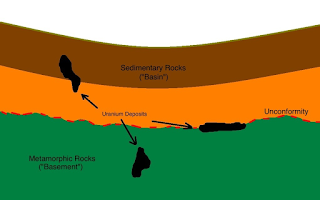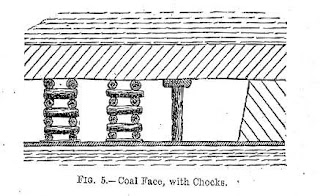surface blast design equations
some empirical equations for surface blast design
1. By Fraenkel 1944.
where:
H = Depth of the blast-hole (m)
2. By Pearse 1955
where:
K = A constant. its value varies from 0.7 - 1.0
Ps = Borehole pressure, MPa
d = Diameter of borehole, m
3. By Langefors and Kihlstrom 1968
Where:
B max = Maximum burden for good fragmentation (m)
D = diameter of hole (m)
ρe =Density of the explosive in the borehole (Kg/m3)
Se = Relative Weight strength of the explosive
f = Degree of confinement of the blasthole.
S/B = Spacing to burden ratio
Co = Corrected blastability factor (Kg/m3 )
= C + 0.75 for B max =l.4-1.5m
= C + 0.07/B for B max < 1.4m
When C = rock constant
ρe =Density of the explosive in the borehole (Kg/m3)
Se = Relative Weight strength of the explosive
f = Degree of confinement of the blasthole.
S/B = Spacing to burden ratio
Co = Corrected blastability factor (Kg/m3 )
= C + 0.75 for B max =l.4-1.5m
= C + 0.07/B for B max < 1.4m
When C = rock constant
4. By Lopez Jimeno, E (1980)
He modifies the ash’s formula by incorporating the seismic velocity to the rock mass, resulting inB= Burden, m
D= Diameter of blast-hole, inches
F= correction factor based on rock group = Fr× Fe
Where:
- ρ' = Specific gravity of rock, gm/cm3
- VC = Seismic propagation velocity of the rock mass
- ρ'' = Specific gravity of explosive charge, gm/cm3
- VD = Detonation velocity of explosive, m/s
5. By Konya and Walter (1990)
Where:
B = Burden, (ft)
ρe = Specific gravity of explosive, (lb/in3)
ρr = Specific gravity of rock, (lb/in3)
D = Diameter of explosive, (in)
Correction factor,
Where:
- Bc = Corrected burden (ft)
- Kd = Correction factor for rock deposition. Its value is as follows,
- • for bedding steeply dipping into cut Kd = 1. 18
- • for bedding steeply dipping into face Kd = 0.95
- • for other cases Kd = 1.0
- Ks = Correction factor for geologic structure. Its value is as follows,
- • for heavily cracked, frequent weak joints, weakly cemented layers Ks = 1.30
- • for thin well-cemented layers with tight joints Ks=1.1
- • for massive intact rock Ks = 0.95
- Kr = Correction factors for number of rows. Its value is as follows,
- • for one or two rows of blastholes Kr = 1.0
- • for third or subsequent rows Kr = 0.95
Konya and walter also suggested the following empirical relationships-
For instantaneous initiations system,
For delay initiation system,
Where,
H = depth of blast-hole, m
B =burden, m
S =Spacing, m
Konya and Walter also suggested the following empirical relationship
Where,
S ANFO = relative strength of explosive
ρr = density of rock, gm/c.c.
d = diameter of blast-hole, m
keywords:










Comments
Post a Comment